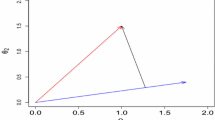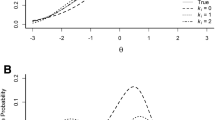Abstract
In a broad class of item response theory (IRT) models for dichotomous items the unweighted total score has monotone likelihood ratio (MLR) in the latent traitθ. In this study, it is shown that for polytomous items MLR holds for the partial credit model and a trivial generalization of this model. MLR does not necessarily hold if the slopes of the item step response functions vary over items, item steps, or both. MLR holds neither for Samejima's graded response model, nor for nonparametric versions of these three polytomous models. These results are surprising in the context of Grayson's and Huynh's results on MLR for nonparametric dichotomous IRT models, and suggest that establishing stochastic ordering properties for nonparametric polytomous IRT models will be much harder.
Similar content being viewed by others
References
Andersen, E. B. (1980).Discrete statistical models with social science applications. Amsterdam: North Holland.
Andrich, D. (1978). A rating scale formulation for ordered response categories.Psychometrika, 43, 561–573.
Bock, R. D. (1972). Estimating item parameters and latent ability when responses are scored in two or more nominal categories.Psychometrika, 37, 29–51.
Ellis, J. L., & van den Wollenberg, A. L. (1993). Local homogeneity in latent trait models. A characterization of the homogeneous monotone IRT model.Psychometrika, 58, 417–429.
Grayson, D. A. (1988). Two-group classification in latent trait theory: Scores with monotone likelihood ratio.Psychometrika, 53, 383–392.
Huynh, H. (1994). A new proof for monotone likelihood ratio for the sum of independent bernoulli random variables.Psychometrika, 59, 77–79.
Junker, B. W. (1991). Essential independence and likelihood-based ability estimation for polytomous items.Psychometrika, 56, 255–278.
Junker, B. W. (1993). Conditional association, essential independence and monotone unidimensional item response models.The Annals of Statistics, 21, 1359–1378.
Lehmann, E. L. (1959).Testing statistical hypotheses. New York: Wiley.
Likert, R. (1932). A technique for the measurement of attitudes.Archives of Psychology, 140, 149–158.
Lord, F. M. (1980).Applications of item response theory to practical testing problems. Hillsdale, NJ: Erlbaum.
Masters, G. N. (1982). A Rasch model for partial credit scoring.Psychometrika, 47, 149–174.
Meijer, R. R., Sijtsma, K., & Smid, N. G. (1990). Theoretical and empirical comparison of the Mokken and the Rasch approach to IRT.Applied Psychological Measurement, 14, 283–298.
Mokken, R. J. (1971).A theory and procedure of scale analysis. New York/Berlin: De Gruyter.
Mokken, R. J., & Lewis, C. (1982). A nonparametric approach to the analysis of dichotomous item responses.Applied Psychological Measurement, 6, 417–430.
Molenaar, I. W. (1982). Mokken scaling revisited.Kwantitatieve Methoden, 3(8), 145–164.
Molenaar, I. W. (1986). Een vingeroefening in item response theorie voor drie geordende antwoordcategorieën [An exercise in item response theory for three ordered response categories]. In G. F. Pikkemaat & J. J. A. Moors (Eds.),Liber Amicorum Jaap Muilwijk (pp. 39–57). Groningen, The Netherlands: Econometrisch Instituut.
Molenaar, I. W. (in press). Nonparametric models for polytomous responses. In W. J. van der Linden & R. K. Hambleton (Eds.),Handbook of modern psychometrics. New York: Springer.
Muraki, E. (1992). A generalized partial credit model: Application of an EM algorithm.Applied Psychological Measurement, 16, 159–176.
Rasch, G. (1960).Probabilistic models for some intelligence and attainment tests. Copenhagen, Denmark: Nielsen & Lydiche.
Rosenbaum, P. R. (1985). Comparing distributions of item responses for two groups.British Journal of Mathematical and Statistical Psychology, 38, 206–215.
Samejima, F. (1969). Estimation of latent trait ability using a response pattern of graded scores.Psychometrika Monograph No. 17, 34(4, Pt. 2).
Samejima, F. (1972). A general model for free-response data.Psychometrika Monograph No. 18, 37(4, Pt. 2).
Stout, W. F. (1990). A new item response theory modeling approach with applications to unidimensionality assessment and ability estimation.Psychometrika, 55, 293–325.
Thissen, D., & Steinberg, L. (1986). A taxonomy of item response models.Psychometrika, 51, 567–577.
Verhelst, N. D., & Glas, C. A. W. (1995). The one parameter logistic model. In G. H. Fischer & I. W. Molenaar (Eds.),Rasch models. Foundations, recent developments, and applications (pp. 215–237). New York: Springer-Verlag.
Author information
Authors and Affiliations
Additional information
Hemker's research was supported by the Netherlands Research Council, Grant 575-67-034. Junker's research was supported in part by the National Institutes of Health, Grant CA54852, and by the National Science Foundation, Grant DMS-94.04438.
Rights and permissions
About this article
Cite this article
Hemker, B.T., Sijtsma, K., Molenaar, I.W. et al. Polytomous IRT models and monotone likelihood ratio of the total score. Psychometrika 61, 679–693 (1996). https://doi.org/10.1007/BF02294042
Received:
Revised:
Issue Date:
DOI: https://doi.org/10.1007/BF02294042




